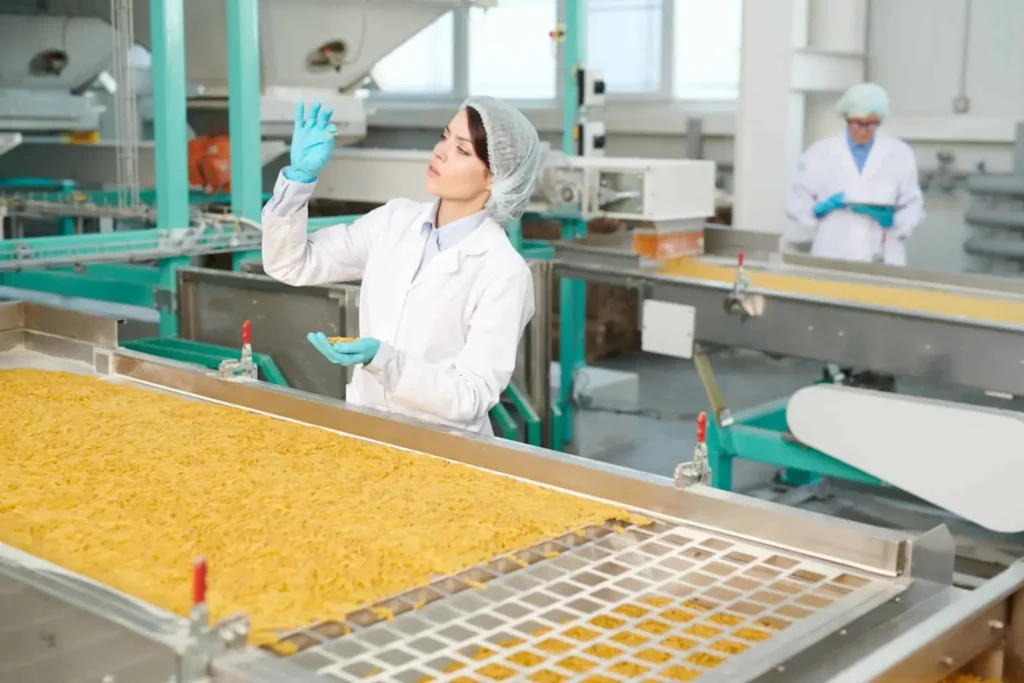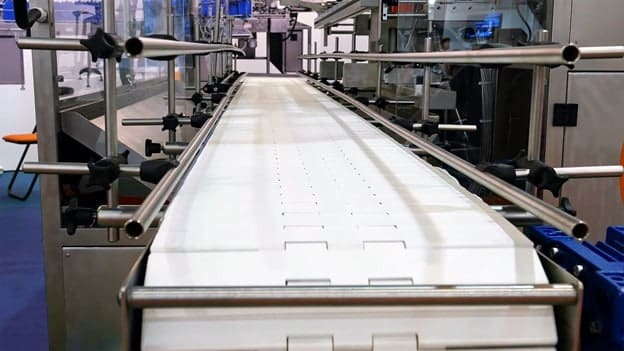Conveyor systems are integral components in material handling and processing industries. But what are industrial conveyor systems used for? These systems are pivotal in optimizing workflow, enhancing productivity, and ensuring the integrity of goods during transport. In this article, we will explore the diverse applications of conveyor systems in various industries, their types, and the pivotal role they play in modern industrial operations.
Short History of Conveyor Systems
Rudimentary conveyor systems date back to ancient times. A screw or auger conveyor was used to transport water for irrigation systems in ancient Greece. Modern-day conveyor systems appeared in the late 18th century. They were short, made from leather and wood, and manually operated. Their original purpose was to transport agricultural products from shore to ships in ports. Conveyor technologies advanced considerably since the first conveyor solutions came about. Nowadays, they are mostly powered by motors (AC motors or sometimes DC motors).
Conveyor Systems Are Vital in Every Production Industry
Manufacturing conveyor systems can be done in various ways, and so can conveyor installation. These systems are vital for many industries – there isn’t a single manufacturing industry that doesn’t utilize a conveyor system. They have become an essential component of the industrial sector. There are dozens of different conveyor types available for purchase. Some of the most commonly used ones are:
- Belt conveyor system,
- Gravity roller conveyor,
- Chain conveyor,
- Slat conveyor,
- Overhead conveyor,
- Bean trolley system,
- Tubular conveying system,
- Pneumatic conveyor.
Where Are Industrial Conveyor Systems Used?
Industrial conveyor systems are all mainly used for transporting materials from point A to point B within a production facility. Still, they have many other applications as well. They can be used in numerous industries, such as:
- Packaging industry,
- Automotive industry,
- Food industry,
- Pharmaceutical industry,
- Chemical industry,
- Computer industry,
- Aerospace industry,
- Agricultural industry,
- Warehouse and logistics,
- Mining industries.
Wherever there are heavy or fragile materials transported from one place to another within the same production area, a conveyor belt system is better suited than human labor. This equipment offers various benefits, such as continuous operation, increased efficiency, reduced risk of worker injury or accidents, faster product output, and reduced costs. You will hardly find a well-developed manufacturing enterprise that doesn’t have at least one conveyor system incorporated into its processes.

What Are Industrial Conveyor Systems Used For?
The two main purposes of industrial conveyor systems are to move products or materials and to store and buffer them. The entire concept of material handling systems came about to satisfy a need for faster and safer ways to carry bulk products or materials. There are various ways conveyors can contribute to a production facility. Let’s take a look at the most common uses for conveyor systems:
- Movement of product from point A to point B – The most common use of an automated conveyor system is to get material from one place in the facility to another. If workers were to do this continuously, they would waste a lot of time walking around the facility. Suppose there is a need for continuous transportation of the same type of material across the same distance. In that case, conveyors drastically reduce forklifts’ movements as well, which you can then utilize elsewhere.
- Carrying heavy loads – Sometimes, moving a load by hand or forklift is not an option due to its size or weight. Products that are too heavy to lift or otherwise transport have no other choice but to be moved by a conveyor system. Unique conveyor solutions made to handle heavier loads are designed for these purposes.
- Assembly operations – Conveyor systems allow operators to work on a product in motion. This application is common in the automotive industry. A final assembly conveyor may slowly move the product along as workers apply finishing touches or complete the auto part. Conveyors that carry the product so that workers can stay in one place as they work on it are frequently seen in production lines.
Conveyor Systems Have an Important Role in Protecting Workers From Injury or Preventing Damage to the Materials
The risk of endangering your workers’ health from repetitive motions they have to perform to move a product is not worth it. Conveyors can get all the work done in the same amount of time (if not faster), and no one gets hurt in the process. Additionally, some products are too fragile to introduce the element of human error into the process of moving them.
Conveyor systems represent a safe way to transport materials and items that can easily be damaged in the move. In extreme cases, a production facility can be free of any manual labor. Instead, robots are the ones that deliver products for processing or receive products from the conveyor. Automated conveyor systems are an essential component of the entire production machinery.
Storing and Buffering Are Additional Uses for Conveyor Systems
Aside from transport, certain types of conveyors can also store products between processes or at the final step of production. Conveyor systems can also be used for creating an accumulation bank. A buffer or an accumulation bank is a flexible storage system. It helps balance the flow of production by either reducing or increasing the number of products in the accumulation bank. Grouping production operations into batches and prioritizing them can be beneficial for your line of work. Conveyors allow managers to sequence and resequence products between processes for maximum productivity.

How Do You Design a Conveyor System?
When looking at conveyor options, you can choose to design the system yourself or, preferably, hire experts in conveyor engineering to do it for you. Dozens of factors need to be considered before conveyor installation – you need the right type of conveyor if your goal is to drastically grow your business. So, what do you need to keep in mind when choosing a new conveyor?
Type of Materials That Will Be Conveyed
The fragility of your materials is a significant factor in deciding on the right conveyor system. Some conveyors prevent breakage, while others can be quite rough on the transported items. Likewise, you need to consider how easily your material flows, whether it is dry or wet, and how abrasive it is.
Conveyor Throughput
Some conveyors have a high throughput (which means they can handle high volumes at once), while others are not as efficient. High throughput is often achieved by sacrificing material integrity since speed tends to break many fragile materials. If this isn’t a concern for you, then a high throughput conveyor is the right choice.
Transport Velocity and Acceleration
Certain types of conveyors, such as pneumatic ones, transport materials at incredibly high speeds. This makes for increased productivity but can lead to material breakage.
Ease of Maintenance and Cleaning
Conveyors that can be cleaned in place (meaning they don’t have to be dismantled) are the easiest to maintain. Those that include ropes or chains can be quite difficult to clean. Additionally, you should consider how easy it is to acquire spare parts for your mechanical handling equipment should you need them in the future.
Energy Efficiency
Conveyors of different sizes and types have different energy requirements. Typically, those that have a large motor require more power. If you want an energy-efficient system, you will need to pay special attention to the power source and its strength.
The Size and Height of Your Available Space
Some conveyors are flexible and can be adjusted to almost any type of space, while others require more room. Your floor space will be a deciding factor in the type of conveyor you choose.
Initial Purchase Cost
Last but not least, you need to make sure that the purchase, shipping, setup, and conveyor installation supervision costs aren’t outside your planned budget.
Cablevey Conveyors Offers Customizable Solutions That Will Make the Conveying Process a Breeze
Cablevey Conveyors offers completely modular and customizable conveyor solutions. This means that our conveyors will fit in your production facilities no matter the size of the space available. Even if your building includes tight corners, is more vertical than horizontal, or overall represents a challenging space for a conveyor system, we will come up with the best conveyor technologies for your production process. Our industrial conveyor systems are ideal for moving specialty materials such as grain, breakfast cereal, coffee, and nuts in a way that is free of dust and contaminants.
Having the Right Conveyor System Is Vital for Production – Contact Cablevey Conveyors for the Best Designs
Industrial conveyor systems have a wide array of manufacturing applications. Every industrial building requires at least one conveyor (but most likely several) to speed up its processes and help it meet its production goals. It doesn’t matter if a business is brewing craft beer or producing paint powders or resins – conveyors are a vital component of an industrial process.
Designing the right conveyor system for your business largely depends on what you will use it for. It also depends on other factors, such as the type of material you’re transporting and the throughput you want to achieve. The good news is that you don’t have to make all the decisions by yourself. Cablevey Conveyors is here for you, and we will help you get the perfect conveyor solutions for your factory – contact us for more information.
FAQ
What Are the Core Purposes of Industrial Conveyor Systems?
Industrial conveyor systems are crucial for the efficient movement and storage of products or materials in manufacturing facilities. They facilitate the safe and rapid transfer of goods from one point to another, reducing the time and labor required for material handling.
Conveyor systems are also set up to carry heavy loads that are impractical to move manually or by forklift. In assembly operations, they enable workers to process products in motion, enhancing productivity and operational flow while ensuring the safety and integrity of the goods and workers involved.
How Have Conveyor Systems Evolved Over the Years?
Conveyor systems have a rich history, with their origins tracing back to ancient Greece, where they were used for water transportation. Initially, these systems were short and manually operated, constructed from leather and wood.
Over the years, advancements in technology have led to the development of modern conveyor systems powered by AC or DC motors. Today, conveyor systems are a vital element in numerous industries, offering enhanced efficiency, versatility, and safety in handling a diverse range of products and materials within production facilities.
What Types of Industries Benefit From Conveyor Systems?
Conveyor systems are ubiquitous across various industries, including packaging, automotive, food, pharmaceutical, chemical, computer, aerospace, and agricultural sectors. They are instrumental in warehouses and logistics, as well as mining industries.
Conveyor systems optimize the transportation of both heavy and fragile materials, ensuring continuous operation, increased efficiency, reduced worker injury risks, faster product output, and cost reduction. Their adaptability and efficiency make them a staple in well-developed manufacturing enterprises globally.
How Do Conveyor Systems Contribute to Worker Safety and Product Integrity?
Worker safety and product integrity are paramount in industrial settings, and conveyor systems play a pivotal role in ensuring both. They mitigate the risks associated with repetitive motions and heavy lifting, reducing workplace injuries. For fragile products, conveyor systems minimize human error, ensuring materials are transported safely and intact. Advanced automated conveyor systems can even eliminate the need for manual labor, with robots handling products, further enhancing safety and efficiency in production environments.
How Are Conveyor Systems Designed, and What Factors Are Considered in Their Installation?
Designing a conveyor system requires considering various factors to ensure efficiency and suitability for specific industrial needs. The type of materials to be conveyed, throughput capacity, transport velocity, and ease of maintenance are critical considerations.
Energy efficiency, available space, and budget also influence the choice of conveyor. Companies like Cablevey Conveyors offer customized solutions, considering all these factors to design conveyor systems that seamlessly fit into diverse production environments, enhancing operational efficiency.
What Are Some Common Types of Conveyor Systems and Their Applications?
There are various types of conveyor systems, each suited for different industrial applications. Belt conveyor systems are commonly used for the continuous transportation of goods, while gravity roller conveyors are ideal for moving boxes or trays. Chain conveyors are used for heavy loads, and overhead conveyors are often seen in automotive assembly lines.
Pneumatic conveyors are preferred for transporting powders and granules, while tubular drag conveyors are used for a variety of delicate products. Each type is designed with specific applications in mind, ensuring optimal performance and efficiency in material handling and processing tasks.






